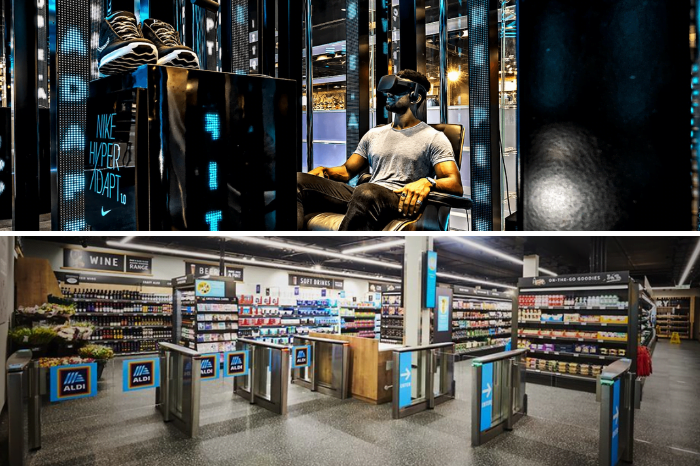The Future of In-Store Technology: Embracing the Change
Retail is undergoing a ruthless renaissance after a transformation almost two decades long. The e-commerce eruption and pandemic lockdowns, as well as the customers’ inclination to spend on services rather than goods, drove the sector to reinvent and go on a future in-store technology adventure.
Retailers require creativity to be one step ahead of everyone and to survive in a dramatically changed global scenario. Companies that experiment with technologies to determine which ones improve operational efficiency and which improve the customer experience are more likely to succeed.
Technology is to be a driving force behind change in the physical structure. This is because technology not only enhances both the shopping and customer experience but also changes customer requirements. The retail industry will have to keep up with emerging technologies and customer demands due to the changing underlying structure of technology. This is key to ensuring a future for high-street retail.
In this blog, we discuss the pressures underpinning the basis of retail technology and examine current retail technology trends to try and determine what will happen next, and their implications for retailers now and in the future.
What is retail in-store technology?
The term “retail in-store technology” encompasses a broad range of solutions and tools. These tools can be implemented to boost operational efficiency and customer experience in physical stores. Digital payments, self-checkout systems, and mobile applications that allow customers to pay on their own are just a few examples of such a widespread change.
It is driven by a paradigm shift called digital transformation, or, in other words, a comprehensive rethinking of an organisation from the inside out, fueled by digital technology. Remaining highly aware of new sources of development and innovation will enable retailers to deliver this chain reaction within the retail sector.
For example, in 2022, Aldi successfully trialled its first check-out free store. Instead of conventional checkout processes, customers scanned a smartphone app upon entering the store and proceeded to select their desired items. After their visit, they received an email receipt and were automatically charged via their preferred payment method.
More innovative ideas for retailers to future-proof their physical stores can be found in our blog ‘Adapting to change: Retail High Street regeneration ideas‘.
Understanding the current role of technology in store retailing
Over the last few years, technology has defined the dynamics of brick-and-mortar stores by rising to the forefront of the industry’s evolution. Retailers have funnelled billions of dollars in IT spending, amassing massive investments as a result.
From the massive expenditure of capital investment, it is evident that industry players consider the innovation of technology as a critical component of modernising operations and the shopping experience. Technology has become a treadmill in retail operations. Key technological elements that have become the norm in-store include features like self-checkout systems, advanced point of sale, QR codes & digital receipts.
The market value for IT spending in retail, according to Simply Wall St., was $5.48 billion in 2023, with a projected future trajectory that will see it grow to $9.07 billion by 2030. The growth trajectory is a depiction of the industry’s unstoppable hunt for technology’s innovative face.
Similarly, as retailers strive to provide executive-integrated shopping experiences, implementing omnichannel strategies has hardly escaped the spotlight. As a matter of fact, the omnichannel approach involves leveraging mobile devices, apps, and websites to deliver a consistent and personalised customer experience, both online and in-store.
Top retail store technology trends transforming shopping
A number of transformative trends are likely to have a significant impact on the future trajectory of retail. These trends encompass a spectrum of technological advancements and strategic initiatives that promise to redefine the way consumers interact with physical retail environments.
Let’s look into some of them:
- Artificial Intelligence (AI): Artificial intelligence stands at the forefront, offering retailers unprecedented capabilities to personalise the shopping experience, fine-tune inventory management, and implement dynamic pricing strategies.
All these features can be tailored to individual preferences and market trends by using generative AI. In short, by using AI, retailers are harnessing the power of machine learning to develop AI-driven personalisation algorithms that enhance the in-store shopping experience.
AI is also emerging as a pivotal tool in security issues and loss prevention. From AI-powered video analytics to RFID tags, AI and machine learning are transforming loss prevention strategies in retail. Many retailers are already leveraging AI’s ability to analyse large volumes of data and provide real-time insights which is revolutionising the fight against shoplifting. This technology helps retailers create a secure shopping environment for both customers and staff.
- Augmented reality technology (AR): In the future, the product visualisation mechanism will change completely. Even nowadays, with the help of AR, consumers can visualise products in real time. This feature significantly increases chances of sale and takes customer engagement to a completely different level. According to TCS Retail Survey US, 60% of millennials are willing to shop or spend more money with a retailer offering virtual fitting rooms or virtual staging capabilities
- Smart Shelves with IoT integration: The Internet of Things (IoT) refers to a network of physical devices embedded with sensors, software, and other technologies. These “objects” are connected to the internet, enabling them to collect and exchange data with other devices and systems.
Integrating the IoT into inventory management helps revolutionise the supply chain. Retailers can have an accurate and on-time view of inventory and customers’ tastes. An important feature of this particular technology is its ability to manage optimal product positioning and mitigate the risk of out-of-stock scenarios.
- Hyper-personalisation: This trend is enabled by data analytics and machine learning algorithms. Through it, retailers can create personalised recommendations and offers that are meticulously tailored for every customer. That creates customer loyalty and increases conversion rates.
- Embedded payments: These types of payments remove the need for a lengthy customer check-out process. They work by integrating payment solutions directly into the shopping experience. This eliminates the need for a lengthy checkout process and expedites front-end payments, ultimately enhancing the overall customer experience.
- Facial recognition technology: Retailers can use this technology to help shorten transaction times, gather useful data to benefit consumers, and become more consumer-centric. Through it, retailers can also provide a personal touch for VIPs and loyalty programme members. Additionally, this technology can help increase store security.
- Sustainable technologies: Retailers increasingly use sustainable technologies, including energy-efficient lighting and recyclable packaging. Changes in consumer behaviour are the driving force behind this, as customers are becoming more environmentally sensitive. This necessitates eco-friendly behaviour on the part of retailers.
- Datafication: This technology offers retailers an opportunity to transform raw data into actionable insights that can be used for strategic decision-making, efficient unit operations, and the overall efficiency of the retail process.
- Free Wi-Fi in Stores: Free high-speed internet within stores provides customers with the opportunity to access digital services, promotions, and loyalty programmes, allowing them to enhance their shopping experience.
- Automation solutions: These solutions range from self-service kiosks to cleaning robots. They have turned the system-work mode of the retail spaces around. They reduce human labour costs, increase productivity and enable retailers to give customers a seamless and smooth shopping experience
How the focus on shopping experience is shaping the future of in-store technology
As the market becomes increasingly competitive, the retail experience is the new battlefield to differentiate. Retailers have to create more than just transactions; they need to generate personalised, engaging experiences. This calls for a unifying approach to personalisation in all contact areas to create and nurture customer loyalty.
Personalisation and customisation are crucial pieces of the strategy to reinvent in the face of massive competition from giants in online retail. An omnichannel solution provides a far greater chance to combine online and offline stores to reach customers, no matter where they are. Furthermore, employing retail loyalty software and rewards systems improves communication with consumers and maximises cross-channel commerce potential.
This approach involves using social media platforms and mobile apps by retailers to extend the reach of their brand and foster ongoing relationships with their customers in real-time.
Examples of future technologies in in-store retailing
Now that we have noted some of the best examples of retail store technology trends that are transforming shopping, let’s look into some real-life examples of how they work:
- AI in Stock Management
An example of AI in the retail sector is Marks & Spencer’s partnership with Texel for AI-supported stock management. Using this AI technology, M&S can get a very precise idea of just what its stock situation and customer need levels are going to be, enabling them to keep popular items stocked on every shelf. This personalised tactic improves the retail store experience by reducing out-of-stock situations and helping customers find what they require.
- Augmented Reality for Virtual Try-On
By utilising augmented reality in a completely novel manner, ASOS now allows customers to virtually try on any piece of apparel before they purchase it! Using augmented reality at ASOS increases engagement and, ultimately, sales. In fact, it allows the customer to feel more like they are really walking into a virtual store.
- IoT-Enabled Smart Shelves
For example, one of the largest supermarket chains in the UK, Tesco, has already introduced smart shelves integrated with the Internet of Things (IoT) in some stores. IoT sensors are used to monitor product levels in real-time on Tesco’s smart shelves.
This technical solution enables Tesco to optimise inventory management and ensure that the shelves are always stocked with the essentials. Thus, this technology also enhances customer service; the incidence of out-of-stock situations is reduced, and consumers can more easily find the required items.
- Hyper-Personalisation in Fashion Retail
Fashion retailer Boohoo uses hyper-personalisation to present different products and discounts that each specific customer may be interested in. Thanks to data analytics and machine learning, they have developed a unique customer experience for their website, enhancing customers’ satisfaction and retention while increasing conversion rates.
- Embedded Payments
Burberry has followed the trend of embedded payments by integrating the payment solution directly into its stores. Customers are now able to make payments inside the Burberry app without being redirected to a third-party page. As a result, the checkout process is much faster, and customers have to wait less.
- Facial Recognition for Personalised Service
L’Oréal is a UK-based company that uses face recognition for virtual try-ons of products like cosmetics. Customers can virtually try on a variety of L’Oréal cosmetics using their smartphones or laptops with the company’s augmented reality makeup try-on technology. In real-time, the customer’s virtual makeup is applied thanks to the facial recognition technology’s precise face mapping. The customer can enhance their shopping experience by trying on different makeup products and seeing the results.
- Advanced Security Measures
John Lewis uses advanced security measures to prevent theft, fraud, and other security threats. These measures include CCTV surveillance systems, access control, and RFID tagging to track the inventory and prevent shoplifting. In other words, the store has to be safe for both employees and customers.
- Sustainability Initiatives
The UK-based Waitrose supermarket chain prides itself on sustainability through the incorporation of LED lighting and biodegradable packaging. These measures correspond with the Waitrose values and expectations of conscious consumers, who demand that the retailer make less of an environmental impact.
- Datafication and Personalised Offers
Being one of the biggest shopping websites, Amazon UK benefits from datafication by tracking their customers’ behaviour and desires. In this way, the company develops its offers based on the data they have collected, sets proper pricing, and provides personalised product recommendations.
- Free Wi-Fi for Enhanced Connectivity
A UK-based department store, Selfridges, provides free Wi-Fi in-store to customers, enabling them to utilise digital platforms and services, including promotions and loyalty activities. Before or during their visit, clients can easily connect to the fast and stable internet connection, which helps them stay connected and engaged while shopping.
- Automation for Efficiency
Apart from the UK examples mentioned above, retailers around the world are experimenting with innovative technologies. Robotic shops are an exciting example of future technologies in in-store retailing. JD, a giant of Chinese online retail, provided the experience in its robotic stores in the Netherlands. Customers can order a variety of products through the Ochama app and witness robotic systems handling tasks like picking and sorting.
- Virtual Reality
Nike uses both augmented reality and virtual reality technologies within its brick-and-mortar stores. Customers can engage in a virtual reality experience, immersing themselves in various stages of Nike’s supply chain to gain insight into the manufacturing process and product origins.
Final thoughts
In conclusion, retailers have reason to be optimistic about the future of in-store technology. Customer experience and digital transformation are strictly intertwined and with this potential, they can improve customer shopping experiences and drive business growth.
Retailers have a chance to succeed in the digital realm if they use consumer-centred strategies and take advantage of new technology. It is essential to stay current on all new retail trends and developments in the retail sector, as it is experiencing changes.
Register free now for The Retail Bulletin’s Future of the High Street conference where we will review future trends in the retail industry and tackle the critical questions shaping the future of retail and leisure.
Embrace change and unlock new opportunities for your retail business.














